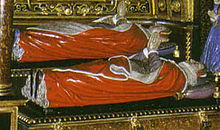- Mildred Cooke
-
Mildred Cooke 
Effigies of Mildred, Lady Burghley, and her daughter, Anne Cecil, Countess of Oxford in Westminster Abbey.Born c. 1525
Gidea Hall, Essex, EnglandDied 4 April 1589
Burghley House, Strand, Middlesex, EnglandKnown for translator and poet Title Lady Burghley Religion Protestant Spouse William Cecil, 1st Baron Burghley Children Anne Cecil, Countess of Oxford
Robert Cecil, 1st Earl of Salisbury
Elizabeth Cecil
Francisca Cecil
William Cecil
William CecilParents Sir Anthony Cooke
Anne FitzwilliamMildred Cooke, Lady Burghley (c.1525–4 April 1589) was an English noblewoman, translator, and poet of the sixteenth century.
Contents
Life and work
Mildred was the eldest of the five daughters of Sir Anthony Cooke and Anne Fitzwilliam. She studied Latin and Greek, which she especially enjoyed translating. Roger Ascham, tutor to Lady Elizabeth Tudor, lauded her for being able to read Greek as easily as English and ranked her and her sisters along side Lady Jane Grey in regards to their erudition.[1] Mildred's sister, Anne, was known for her translation from Latin of John Jewel's Apologie of the Anglican Church (1564). Lady Burghley's daughter, Anne Cecil, followed in her mother's footsteps and was a prolific poet and sonnet writer. Anne would go on to marry the poet and playwright Edward de Vere.[2]
On 21 December 1545, at the age of twenty, she married William Cecil, as his second wife. Cecil would become Elizabeth's most trusted advisor after she gained the throne in 1558. Mildred was described by several Spanish Ambassadors as a "furious heretic with great influence over her husband".[3] In a letter of 1567, the Spanish Ambassador called Mildred a much more "furious" heretic than her husband, but Mildred proved to be more concerned with domestic matters than those at the court. Mildred was, however, briefly at Elizabeth's court as a lady of honor in the privy chamber at the beginning of the reign. She and her husband quite frequently entertained the Queen at their many residences, including Burghley House.[3]
From then on many sought her advice and support. Elizabeth sometimes entrusted her with political matters, especially with those related to Scotland.[4]
Mildred never published her many translations, but instead spent her time on charity. She did however translate and circulate a manuscript of St. Basil's homily on Deuteronomy in around 1550.[5] Mildred dedicated her work to Anne Stanhope, Duchess of Somerset, wife of Edward Seymour, 1st Duke of Somerset.[5] Mildred had served in the Duchess's household before her marriage to Lord Burghley.[5] In her charity, which was kept secret from her husband, Mildred provided an exhibition for two scholars and four quarterly sermons at St. John's College in Cambridge, Cecil's old college. Books, some in Greek and Hebrew, were also contributed to the St. John's College in Cambridge, Christ Church, Oxford, and Westminster College.[3]
For many years after their marriage Lord and Lady Burghley had no children.[6] A daughter, Francisca, was the first born but did not survive long.[6] In 1556, another daughter named Anne was born.[6] Two boys, both named William, followed in 1559 and 1561 but died in infancy.[6] Then in 1563, another son was born, Robert; the successor of his father at court and the future Earl of Salisbury.[6] Their final child, a daughter name Elizabeth, followed in 1564.[6]
Lady Burghley had charge of her children's education as well as that of the various wards her husband was responsible for, including Robert Devereux, 2nd Earl of Essex and Edward de Vere, 17th Earl of Oxford.[2]
Lady Burghley died on 4 April 1589 after 43 years of marriage. She was buried with her daughter, Anne, Countess of Oxford, in Westminster Abbey where an enormous Corinthian tomb twenty four feet high was erected. The effigy depicts the figure of Lady Burghley as she lies on a sarcophagus; at her head are her three granddaughters Elizabeth, Bridget, and Susannah de Vere and at her feet her only son Robert Cecil. In a recess is the recumbent figure of the Countess of Oxford. In the upper story Lord Burghley is seen kneeling in his robes. The epitaphs are from his pen and tell how his eyes were dim with tears for those who were dear to him beyond the whole race of womankind. Lord Burghley himself lay in state here but was buried at Stamford. A long Latin inscription on the tomb was added by Lord Burghley.[6]
There are two known portraits of Lady Burghley; they are both at Hatfield and are by the Master of Mildred Cooke. One of her shows her during a pregnancy, probably that of 1563 (both portraits have more recently been attributed to Hans Eworth).[2]
In fiction and film
Lady Burghley was portrayed in the movie Anonymous (2011) by Anna Altmann.
Notes
- ^ Robin, Larsen and Levin. p. 74.
- ^ a b c Kathy Lynn Emerson. Who's Who in Tudor Women. Mildred Cooke
- ^ a b c Cathy Hartley. A Historical Dictionary of British Women, Psychology Press, 2003. pg 190.
- ^ Robin, Larsen and Levin. p. 74.
- ^ a b c Anne Lawrence-Mathers, Phillipa Hardman. Women and Writing, C.1340-c.1650: The Domestication of Print Culture, Boydell & Brewer, 2010. pg 63-69.
- ^ a b c d e f g George Ravenscroft Dennis. The Cecil Family, Houghton Mifflin Company, 1914. pg 43.
References
- Robin, Diana Maury, Larsen, Anne R. and Levin, Carole (2007). Encyclopedia of women in the Renaissance: Italy, France, and England. ABC-CLIO, Inc.
Categories:- 16th-century translators
- 1526 births
- 1589 deaths
Wikimedia Foundation. 2010.
